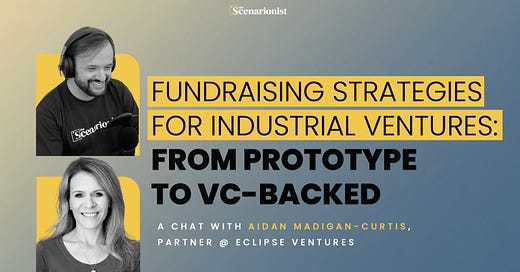✨ This is a Free Edition of The Scenarionist. To enjoy the full experience, become a Premium Member!
Welcome to the 68th edition of Deep Tech Catalyst, the channel by The Scenarionist, where science meets venture!
In the world of deep tech, building a working prototype is just the beginning. For founders spinning out of labs or R&D teams, the real challenge isn’t just technical—it's translating scientific breakthroughs into businesses investors want to back. Especially in hardware and industrial ventures, where capital intensity is high, go-to-market is complex, and margins are hard-won.
In this episode, we sit down with Aidan Madigan-Curtis, Partner at Eclipse Ventures. With years of experience helping early-stage deep tech companies scale from concept to commercialization, Aidan shares a tactical view of what makes a pre-revenue startup investable—and what separates scalable business models from expensive science projects.
Together, we dive into:
How to validate industrial markets and engage corporate buyers—even at TRL 4/5
What a truly VC-backable pitch deck looks like for hardware founders
The critical business model decisions that make or break scale in manufacturing
How founder-CEOs can grow into world-class leaders without giving up the reins
Whether you’re building an industrial startup from scratch or refining your fundraising narrative for pre-seed investors, this episode offers an essential roadmap to turning prototypes into venture-grade companies.
Let’s get into it! 🚀
✨ For more, see Membership | Partnership | Deep Tech Briefing | Insights
KEY INSIGHTS FROM THE EPISODE
From Prototype to Venture-Backed
When founders approach venture capitalists at the pre-revenue stage — especially those working on deep tech or science-driven startups — a common question arises: How can I build a company that’s ready for investment, even if I’m only at TRL 4 or 5, with a working prototype but no commercial traction?
Start With the Problem, Not the Technology
One of the most important steps for any founder in the early phase is resisting the urge to lead with the technology. Instead, start with a deep understanding of the customer’s problem.
The goal is to pinpoint a specific pain point for a well-defined customer—one that’s not only technically solvable but also economically meaningful.
If the problem impacts a broad segment of customers within a large industry, and if it’s costing them real money, then solving it creates strong market potential.
Scope the Economic Value
From there, work backward.
Quantify the pain: How much is the problem costing the customer?
Estimate your solution’s cost: What would it cost to build your product?
Define the price point: How much could you reasonably charge for the solution?
If your technology costs $20 to produce and delivers enough value that the customer would happily pay $100 — and that $100 solution helps them save even more in operational efficiency — you’re beginning to establish an ROI case. High gross margins, plus clear customer benefit, are a compelling combination.
Talk to Real People — Strategically
For scientific founders who may be less familiar with their target market, direct customer engagement is critical. But that doesn’t mean jumping straight into a sales pitch.
If you’re still identifying the problem you’re solving, there are smart, low-risk ways to do customer discovery. You can approach an expert network that can get you calls with dozens of decision-makers — VPs, C-suite execs, engineers, or whoever your buyer might be — for a relatively small cost.
These conversations are valuable because they:
Let you ask detailed questions to people who actually represent your future customers
Don’t put your product or idea at risk (it’s not a pitch)
Help you refine your understanding of the market pain and potential value
It’s a fast, safe way to collect feedback and build conviction before burning real customer introductions or building out a solution.
Use a "Paper Pitch" Before You Build
Once you’ve collected enough insights and believe you understand both the pain and your proposed solution, the next step isn’t product development — it’s a paper pitch.
Before you write a single line of code, before any schematics, you put together a deck.
This “paper pitch” outlines:
The customer pain
Your solution
What it might cost
What it might look like to engage commercially
You can then take this pitch into early conversations — either with warm intros from investors, expert network contacts, or cold outreach on LinkedIn. What you’re testing is not just interest, but intent.
If five out of ten people say, ‘Yes, where can I sign up?’ and a few more say, ‘That’s interesting, keep me posted,’ you’re probably onto something.
This isn’t full validation, but it’s real signal. If most people in your target segment aren’t intrigued — or don’t see real value in what you’re proposing — you may need to revisit the pain point or your solution approach.
Identifying the Right Stakeholders in B2B Hardware Sales
Once you've validated that there's a real problem to solve and built a compelling paper pitch, the next challenge is knowing who to talk to within a potential corporate customer. Especially in B2B hardware, where adoption involves multiple layers of decision-makers, founders must be deliberate in choosing their points of contact.
So, who are the key stakeholders you should engage with, especially if you're coming from a technical background and starting straight out of university?
Don't Just Talk to Innovation Teams
Innovation departments are often the easiest way in. They’re usually enthusiastic about new technology and open to pilots. But there's usually a limitation to consider:
“Innovation teams are often interested in new technologies, but often don't have a budget to do anything other than a pilot.”
In other words, innovation teams can be helpful for feedback and experimentation — but rarely are they the ones who can sign off on real deployments. If you want to move beyond a pilot, you’ll need broader buy-in.
Talk to the Business Owner First
The most important stakeholder in validating your value proposition is often the business unit leader — the person who owns the problem your solution is designed to solve. These leaders are ultimately responsible for results. If your technology can improve efficiency, reduce costs, or increase throughput in a measurable way, they’ll recognize the ROI, and they’ll have a much stronger incentive to push for adoption.
Include the End User Early
Even if the business leader sees the value, the actual users of the technology can make or break adoption.
You can get alignment with a business leader, but if your tech doesn’t fit into current workflows, users will resist — and you’ll lose the contract.
User feedback helps ensure that your solution is not just valuable but usable. The best time to incorporate their perspective is early — during validation and before significant product development. If you can build something that delights users while solving real problems, adoption becomes much easier.
Don’t Forget IT, Ops, and Finance
Depending on the size of the company, several other departments may also need to sign off, or could block your progress if ignored:
IT / CIO's Office: Particularly in hardware and connected systems, implementation often requires integration with existing infrastructure. IT teams will want to ensure cybersecurity, network integrity, and compliance.
You don’t want to get to the finish line and have IT run multiple tests before giving the green light.
Operations / COO: For technologies that change physical workflows, the operations team will want assurance that deployment won’t create bottlenecks or require massive retraining.
Finance / CFO: If you’re pursuing a larger deal, or if the department doesn’t have discretionary budget, the finance team may need to approve the spend.
Ask your primary contact whether they have the authority to make a purchasing decision.
The key takeaway? Map your stakeholder landscape early. Understand not just who likes your idea, but who can say yes, and who can say no.
Building an Early-Stage Pitch Deck That Speaks to Investors
Let’s say you’ve gotten positive signals from a potential customer. You now have proof that your technology could work in the real world. But to take the next step you need capital. So, how do you build a compelling pitch deck that gets early-stage VCs excited about your hardware startup?
VCs Are Looking for Massive Potential
First, it’s essential to understand the VC mindset.
“Remember when you're talking to VCs, the way that VCs make money is by participating, having an equity ownership stake in the very few companies that make it to a massive exit, are worth $10 billion, $20 billion when they exit to the public markets. And in that respect, VCs care the most about knowing that the people in front of them giving the pitch that the problem they're solving and the solution they're bringing is meant to solve a problem big enough in a market big enough that they can become a 10 billion, $20 billion public company, right? There are a lot of outcomes that end in a different place. You get acquired or whatever. But when VCs write that first check, they're always gunning for the biggest winners. So in my experience, it's best to start your pitch deck with the massive, awful problem that you're solving and why it is of such incredible value to solve it.”
With that in mind, your pitch needs to show that:
You’re solving a huge problem
Your market is big enough to support a multi-billion-dollar company
Your solution is differentiated and defensible
Your team is uniquely qualified to win
Let’s break that down.
1. Start With the Problem — and Make It Big
Don’t ease into the story. Start bold. Begin your pitch with the massive, painful problem you’re solving.
This should be a problem that’s painful enough, urgent enough, and widespread enough that solving it creates enormous value.
Don’t just list market stats. Show that your customer has a bleeding-neck problem that demands a solution — one they’re willing to pay for and adopt quickly.
2. Show a Unique and Scalable Solution
After presenting the problem, walk through your solution. Be clear about what makes it different — and why others can’t just copy it.
Powerful questions: “What’s unique, cutting-edge, and authentic about your approach? What makes it hard to replicate?”.
This could be:
Proprietary technology
A unique go-to-market strategy
Deep industry knowledge
Early traction or customer insights that no one else has
Ideally, you’ve built a moat — or at least have a clear plan to build one. The point is to show why your startup isn’t just a good idea, but the right team with the right angle at the right time.
3. Make the Customer ROI Crystal Clear
Your pitch should also clearly explain the value your solution delivers to the customer.
It’s not enough to say, ‘This is a big market.’ Show that the customer has a huge pain, and that you’re solving it in a way that drives outsized ROI.
This means quantifying how much time, money, or risk your product saves. Show investors that adoption won’t be a hard sell — customers will be pulling the product from you.
4. Convince Them You're the Right Team
Finally, no pitch is complete without a strong team slide.
Investors have to believe this is the team that’s going to turn a prototype — or even just a concept — into a $10 billion company.
Highlight:
Your domain expertise
Relevant past experience
Technical or operational skills
The team’s grit, network, and ambition
Even in deep tech, execution matters. VCs want to know this isn’t just a smart team, but one that can build and scale under pressure, in a crowded, competitive market.
How to Design a Scalable Business Plan for a Hardware Startup
So, how do you create an investable and scalable business plan when you're building hardware? It starts with the business model.
Start With the Right Business Model
If you don’t have a strong grasp of your business model, it’s difficult to make the right strategic decisions.
The business model isn’t just how you charge customers — it shapes everything from product design to sales strategy to inventory and hiring.
A few key questions to ask:
Is your product a one-time sale, or is there a recurring component like a subscription?
Could you offer a consumption-based or transactional pricing model?
Will you land and expand, starting with a small deployment and growing within the customer’s organization?
Each of these affects what your margins need to be, how quickly you must deliver value, and how you manage inventory, supply chain, and cash flow.
Example: Land and Expand Gone Wrong
If you’re working with a land-and-expand business model, your product needs to be immediately usable from the moment it “lands.” If it’s not, expanding within the customer’s organization becomes extremely difficult.
Now, imagine your business model assumes that you’ll make only 20% of a customer’s lifetime value in the first year or two—through that initial deployment and a small expansion. The remaining 80% is expected to come from broader adoption across their entire operations.
But if those expansions don’t happen, you may have priced your product wrong. Worse, you may have built something that costs too much to deliver upfront, based on assumptions that never materialize. For example, if the customer’s lifetime value is projected at $250,000, and your delivery costs are based on spending 20–30% of that to serve them, everything breaks down if the first deployment is all you get. If the “land” stage costs you as much as you make—and no further expansion comes—your business becomes unsustainable. That’s how you end up upside down.
Factor in COGS, Supply Chain, and Inventory Strategy
In hardware, scalability means more than just customer interest. You need to control your Cost of Goods Sold (COGS) and build a supply chain strategy that matches your model.
If you’re offering trials or fast deployment, you may need inventory on hand — and that means managing manufacturing locations, bills of materials (BOMs), and lead times strategically.
But if your model is consumption-based, and your COGS are high or unpredictable, rapid growth could sink your cash position. A prototype might be affordable at a small scale, but if the customer loves it and starts expanding usage, you could run out of runway — not from failure, but from success.
Understand Cloud and Infrastructure Costs at Scale
Today, most hardware startups also have a cloud component. Whether it’s a device management backend, analytics dashboard, or connected service, the cloud costs can creep up fast.
Cloud credits from hyperscalers can be helpful early on. But at scale, they’re no substitute for volume pricing — and those costs can grow faster than your revenue if you’re not careful.
Founders should model the cost of servicing a customer both before and after scale, including cloud, infrastructure, and customer support, to ensure the business stays healthy over time.
Track and Optimize Customer Acquisition
On the sales and marketing front, avoid falling into the trap of untested assumptions.
Founders test everything from growth marketing to sales reps dialing for dollars. That’s fine — just make sure you’re collecting data.
Over time, prune what doesn’t work and double down on the channels or tactics with the highest ROI. This data-first mindset helps you build a repeatable, scalable acquisition engine — something investors will want to see.
Build HR Infrastructure Early — Especially Compensation
Scaling isn’t just about customers — it’s also about people. And one of the most common mistakes hardware startups make?
They build their early team with no clear compensation structure — and it creates huge problems down the road.
Founders often base offers on gut feeling or previous salaries. But this leads to inequity, internal confusion, and challenges with retention as the team grows.
Instead, start from day zero with:
Clear compensation bands by role, equity, and experience
Competitive benchmarks (available even for early-stage companies)
A structured philosophy for raises and promotions
You don’t have to follow industry benchmarks exactly. But you do need a framework — one that helps you scale your team consistently and fairly.
Without it, correcting course later can be painful and morale-damaging.
Do Founders Need to Know Everything from Day One?
As we’ve walked through the process of validating a problem, engaging stakeholders, building a business model, and pitching to investors, one question inevitably comes up, especially from first-time founders: “When am I supposed to learn all of this?”
Is this knowledge something you absorb by doing? Can it be taught? Should a founder expect to stay on as CEO through every phase — from prototyping to IPO — or is there a point when someone more experienced should take the helm?
Two Valid Paths: Evolve or Hand Off
Both paths are valid. Some founders build their companies from scratch and grow with them all the way to public markets. Others choose to step aside at the right moment, bringing in seasoned executives to lead through scale.
There are founders who’ve stayed as CEO all the way through. Others have taken on different roles as the company matured.
There’s no single blueprint. But for those founders who do want to stay at the helm long-term, certain traits are nearly universal.
Open-minded Learning Machines
The most successful long-term founder-CEOs are not just visionaries or technical experts.
Most founder CEOs are smart. They have strong opinions. But the ones who make it all the way also know that every stage of company building requires different muscles.
From early product-market fit to managing Fortune 100 customers, the job of CEO evolves radically. And so must the founder.
The key is to recognize that:
What made you successful in the early phase (scrappy execution, hacking, speed) may not serve you later
Leadership at scale requires new behaviors — structure, maturity, strategic delegation, and trust-building
You need to constantly seek out patterns, learn from other CEOs, and build a personal compass for growth
Build Your Own Path — With Help
To do this, founders should build a community of peers and mentors. Talk to your investors. Talk to your board. Connect with founders one or two stages ahead. The best leaders ask lots of questions and collect multiple perspectives before forming their own.
One CEO’s advice isn’t enough. Markets shift. Business models differ. The right playbook five years ago may not work today. Talk to four or five people, spot the patterns, and build your own signal.
And most importantly — realize that you don’t have to be perfect. You just have to be committed to evolving.
Final Thoughts: Building an Investable Industrial Venture
Creating a venture-backable company in the hardware or advanced manufacturing space is not a straightforward task. It requires:
Deep understanding of the customer’s problem
Strategic engagement with corporate stakeholders
A business model that’s grounded in economic reality
A clear, high-potential pitch for investors
Thoughtful operations, from supply chain to cloud costs to HR
And above all, a founder who’s willing to learn and adapt at every stage
As you move from lab to market, from prototype to product, from founder to leader — surround yourself with people who challenge you, support you, and help you grow.
✨ Join The Scenarionist Premium today!
Unlock access to our exclusive Venture Guides, and much more—available only to our premium members. This includes our carefully curated list of 30 Venture Lessons to Build and Back Great Deep Tech Companies, distilled from the insights of 50+ Deep Tech investors and experts from around the world.
THIS WEEK ON THE SCENARIONIST PREMIUM:
The Industrial Flywheel: How to Engineer Demand Before Building Your Factory | Chapter 1/2
How do you engineer demand before you build capacity? Not through hype or premature commercialization, but by generating meaningful early signals—relationships, partnerships, and structured commitments—that shape your roadmap and reduce downstream risk.
What You’ll Learn in This Edition
What are the core pillars of demand engineering in industrial innovation?
How do you convert early interest into tangible signals?
What frameworks help align technical development with real commercial pull?
How can regulation act not as a barrier, but as a catalyst for demand?
And what kind of team structure best supports a demand-led growth strategy in deep tech?













